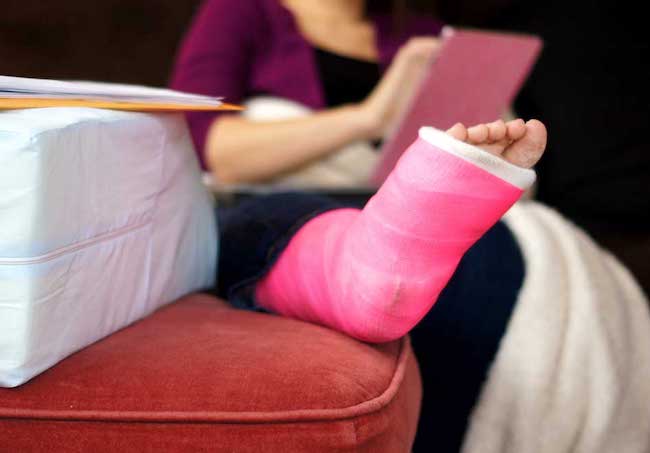Auto Accident Leg Injury Attorney in Dallas
 If you are looking for an auto accident leg injury attorney in Dallas, call our Dallas auto accident attorneys at the Law Office of Doug Goyen at (972) 599 4100. We will start working on your case immediately. We have represented Dallas area residents for auto accident injuries since 1997. The Law Office of Doug Goyen has settled thousands of car accident cases for millions of dollars for our clients. We provide powerful, experienced, and aggressive representation for our clients. You can count on us to get the compensation you deserve for your case.
If you are looking for an auto accident leg injury attorney in Dallas, call our Dallas auto accident attorneys at the Law Office of Doug Goyen at (972) 599 4100. We will start working on your case immediately. We have represented Dallas area residents for auto accident injuries since 1997. The Law Office of Doug Goyen has settled thousands of car accident cases for millions of dollars for our clients. We provide powerful, experienced, and aggressive representation for our clients. You can count on us to get the compensation you deserve for your case.
Call For A Free Case Review (972) 599 4100
LEG INJURIES FROM AUTO ACCIDENTS In Texas it is the wrongdoer’s responsibility to “right the wrongs” that they caused, they must correct the injury and damage they caused due to negligence. If you suffered a leg injury due to negligence, you need to hire an attorney to help you recover the full compensation you are owed due to the negligence of the person who caused your injury.
In Texas it is the wrongdoer’s responsibility to “right the wrongs” that they caused, they must correct the injury and damage they caused due to negligence. If you suffered a leg injury due to negligence, you need to hire an attorney to help you recover the full compensation you are owed due to the negligence of the person who caused your injury.
There are several different types of leg injuries people can suffer due to auto accidents. They include:
Broken leg/fractures. A broken leg (leg fracture) is a break or crack in one of your leg’s bones. Falls, car accidents, and sports injuries are all common causes.
The location and severity of the injury determine how a broken leg is treated. A severely broken leg may necessitate surgery to implant devices into the broken bone to keep it aligned during healing. Other injuries may necessitate the use of a cast or splint. In all cases, timely diagnosis and treatment of a broken leg is critical to full recovery.
Tibia fractures. The tibia, also known as the shinbone, is the most frequently fractured long bone in the body. A tibial shaft fracture occurs along the bone’s length, below the knee, and above the ankle.
This type of broken leg is usually caused by a significant force. Accidents involving motor vehicles, for example, are a common cause of tibial shaft fractures. The smaller bone in the lower leg (fibula) is often broken in tibia fractures.
Fibula fractures. High-energy injuries, such as motor vehicle accidents and pedestrians struck by cars, can cause fibula fractures.
The fibula is a non-weight-bearing bone that begins just below the lateral tibial plateau and extends distally to form the lateral malleolus, which is the portion of the fibula that extends distal to the superior articular surface of the talus. The lateral malleolus is important for preventing excessive ankle and foot eversion. The fibular head is the site of attachment for the lateral collateral ligament of the knee and the biceps femoris tendon. The common peroneal nerve wraps around the fibular neck just below the fibular head before dividing into deep and superficial branches at the proximal fibula.
Femur shaft fractures. The longest and strongest bone in your body is your thighbone (femur). Because the femur is so strong, breaking it usually requires a lot of force. Automobile accidents, for example, are the leading cause of femur fractures.
The femoral shaft is the long, straight part of the femur. A femoral shaft fracture occurs when there is a break anywhere along this length of bone. To heal, this type of broken leg almost always necessitates surgery.
Achilles Tendon Rupture. What Is the Achilles Tendon, Exactly? A tendon is a band of tissue that connects a muscle to a bone. The Achilles tendon runs down the back of the lower leg, connecting the calf muscle to the heel bone. By lifting the heel off the ground, the Achilles tendon, also known as the heel cord, assists in walking.
A ruptured Achilles tendon is a complete or partial tear caused by stretching the tendon beyond its capacity. Forceful jumping or pivoting, as well as sudden running accelerations, can cause the tendon to overstretch and tear. Tripping or falling can also result in a tendon injury.
The Achilles tendon can be injured in a variety of ways, including a minor car accident where the foot is braced on the brake during impact.
Types of dislocations of the leg in the knee area:
Femur and tibia dislocation. Knee dislocations are extremely traumatic injuries that can result in limb loss. Knee dislocations are considered one of the most serious knee injuries, despite being one of the rarest, due to the potential neurovascular damage associated with this injury. The true frequency of knee dislocations is unknown due to spontaneous reductions. Unreduced dislocations have a clear deformity, but spontaneously reduced dislocations can cause the examiner to underestimate the severity of the injury, putting the limb at risk. Following a knee dislocation, the patient must undergo a lengthy and difficult rehabilitation program that must focus on a full range of motion and strength in order to achieve functional recovery.
A sudden, extremely violent force, such as a car accident, is commonly responsible for high-velocity dislocations. High-velocity dislocations cause extensive damage to the knee complex’s structures, including disruption of soft tissues such as the joint capsule, popliteal tendon, menisci, and cartilage. They are also more likely to be associated with neurovascular damage.
Forced hyperextension is the most common mechanism of injury for an anterior dislocation. This type of hyperextension is common in car accidents.
A direct force on the tibia while the knee is flexed, forcing the tibia posteriorly on the femur, is the most common for posterior knee dislocation. This is primarily caused when the tibia collides with the dashboard.
Patella dislocation. When the patella (kneecap) that sits over the front of the knee comes out of its groove at the end of the thigh bone (femur), it comes to rest on the outside of the knee joint, this is referred to as a dislocated kneecap. The supporting ligaments and tendons may be stretched or torn as a result of this. When you bend or straighten your leg, the kneecap normally glides smoothly over a groove in the joint; however, if the kneecap is dislocated, you may be unable to bend or straighten your leg. A dislocated kneecap is a common injury that can take up to 6 weeks to recover from. If you have previously dislocated your kneecap, it is far more likely to dislocate again in the future.
Trauma, including a direct blow to the knee, which is common in car accidents—is a common cause of a dislocated kneecap.
Knee Injuries. Knee injuries caused by auto accidents.
Ankle Injuries. Ankle injuries caused by auto accidents.
Foot Injuries. Foot injuries caused by auto accidents.
FREE CASE REVIEWSIf you or someone you know needs the assistance of an auto accident leg injury attorney in Dallas case call (972) 599 4100 for a free consultation and a free strategy session with a personal injury attorney in Dallas regarding your case. The strategy session includes a summary of your case, identification of the legal issues involved with your case, and identifying those legal issues that will help maximize your recovery in your case. We will email a copy of this strategy session to you for you to keep. Call us today.
WHAT WE CHARGE – CONTINGENCY FEEYou will not be charged unless and until you win! If we work on your case, we charge a contingency fee, which means we don’t get paid if we don’t win. We are compensated based on how well we do – our interest is the same as yours.
OUR OFFICE LOCATIONSADDISON/NORTH DALLAS OFFICE
15851 Dallas Pkwy #605
Addison, TX 75001
Map and Driving Directions
Toll-Free: (855) 599-4100
Phone: (972) 599-4100
Fax: (972) 398-2629
douggoyen@goyenlaw.com – office email
DALLAS BACHMAN LAKE AREA OFFICE
9502 Webb Chapel Rd #205
Dallas, TX 75220
(By Appointment Only)
Map and Driving Directions
Toll Free: (855) 599-4100
Phone: (972) 599-4100
Fax: (972) 398-2629
Spanish Line: (214) 366 4444 (Robert Bobadilla, Office Manager)
douggoyen@goyenlaw.com – office email
By Doug Goyen, douggoyen@goyenlaw.com
Related Dallas Motor Vehicle Accident Pages:
- Car Crash Lawyer
- Bicycle Accident Lawyer
- DWI Accident Lawyer
- Dram Shop Lawyer
- Motorcycle Accident Lawyer
- Pedestrian Accident Lawyer
- Truck Accident Lawyer
- Wrongful Death Lawyer
Related Personal Injury Pages:
- Construction Accident Injury Lawyer
- Dog Bite Lawyer
- Personal Injury Attorney
- Premises Liability Lawyer
- Workplace Injury Lawyer
Related Injuries in Accidents Pages:
- Common injuries caused by accidents
- Catastrophic Injury
- Brain Trauma
- Spinal Cord Injury
- Burn Injuries
- Internal Organ Injury
- Adrenal Injury
- Back Injuries
- Neck Injuries
- Bulging Discs and Herniated Discs
- Anterolisthesis Defined
- Cervical Radiculopathy
- Soft Tissue Injury
- Whiplash Injury
- Chest Injury
- Pelvis & Hip Injury
- Leg Injury
- Knee Injury
- Torn ACL Knee Injury
- Collateral Ligament Knee Injury
- Ankle Injury
- Foot Injury
- Facial Injury
- Eye Injury
- Orbital Fracture
- Detached Retina
- PVD Eye Injury
- Eye Floater Injury
- Shoulder Injury
- Rotator Cuff Injury
- Arm Injury
- Wrist Injury
- Hand Injury
- Acute Injury Defined
- Amnestic Defined
- Post-Traumatic Arthritis
- Different Types of Fractures
- Concussions
Communities Served:
- Addison Car Crash Lawyer
- Allen Car Crash Lawyer
- Arlington Car Crash Lawyer
- Azle Car Crash Lawyer
- Balch Springs Car Crash Lawyer
- Bedford Car Crash Lawyer
- Benbrook Car Crash Lawyer
- Burleson Car Crash Lawyer
- Carrollton Car Crash Lawyer
- Cedar Hill Car Crash Lawyer
- Cleburne Car Crash Lawyer
- Dallas Truck Crash Lawyer
- Denton Car Crash Lawyer
- Desoto Car Crash Lawyer
- Duncanville Car Crash Lawyer
- Far North Dallas Car Crash Lawyer
- Farmers Branch Car Crash Lawyer
- Flower Mound Car Crash Lawyer
- Fort Worth Car Crash Lawyer
- Frisco Car Crash Lawyer
- Garland Car Crash Lawyer
- Grand Prairie Car Crash Lawyer
- Grapevine Car Crash Lawyer
- Irving Car Crash Lawyer
- Lancaster Car Crash Lawyer
- Lewisville Car Crash Lawyer
- McKinney Car Crash Lawyer
- Mesquite Car Crash Lawyer
- Oak Cliff Car Crash Lawyer
- Plano Car Crash Lawyer
- Richardson Car Crash Lawyer
- Rockwall Car Crash Lawyer
- Rowlett Car Crash Lawyer
- Sherman Car Crash Lawyer
- Wichita Falls Car Crash Lawyer
 Doug Goyen Home
Doug Goyen Home











